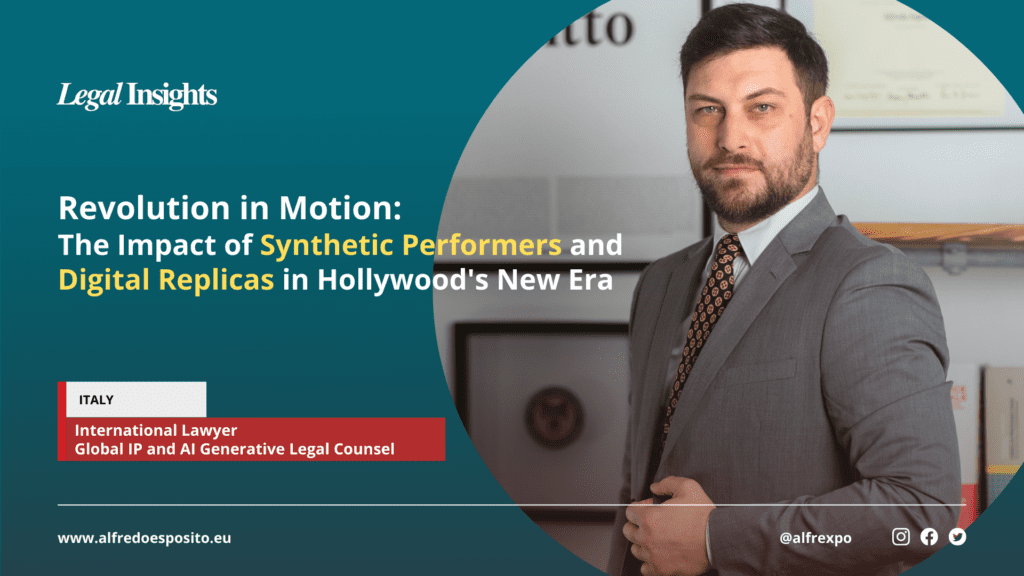
The entry into force of the agreement between SAG-AFTRA (Screen Actors Guild-American Federation of Television and Radio Artists) and the AMPTP (Alliance of Motion Picture and Television Producers) signifies a crucial evolution in the contractual dynamics of global audiovisual production. This three-year agreement, signed on November 8, 2023, is set to have a profound impact beyond the immediate parties, especially considering Hollywood’s influential role in the global industry and the staggering economic stakes involved, amounting to over 3 billion euros.
A Paradigm Shift in Entertainment Law and Economics
The legal world and the entire entertainment industry have focused predominantly on the groundbreaking clauses pertaining to the use of artificial intelligence in audiovisual performances and film productions.
This follows the earlier agreement between the WGA (Writers Guild of America) and the AMPTP, indicating that the actors’ union has now also formally embraced the official introduction of generative artificial intelligence.
Beyond the economic value of the agreement, the predominant attention of the legal world and the entire entertainment industry was focused on the introduction of revolutionary clauses governing the use of AI in the movies industry.
Let’s examine the highlights of the agreement, where references to performers are used to refer to actors and artists in the entire industry, and where not only compensation but also consent on the use of one’s digital replicas after death is discussed.
Digital Replication and Alteration of Performers
The clause Digital Replication and Alteration of Performers refers to the digital creation, use, and modification of performers’ performances, including both digital replications and digital alterations made to already recorded performances. The subsections are divided into two macro-categories: “Employment-Based Digital Replica” and “Independently Created Digital Replica“
Employment-Based Digital Replica
The Employment-Based Digital Replica is a digital duplicate of a performer’s voice or appearance created in the context of a production where a labor agreement is in place. Such a “replica” would be generated using digital and generative artificial intelligence technologies, with the physical participation of the performer. The ultimate production goal is to achieve a representation of the performer in audiovisual products even in the absence of the actual performance.
Consent Required: Explicit consent is required. If the claimant is deceased and consent is required for the use of the digital replica, it may be granted by an authorized representative of the deceased claimant. In the event that an authorized representative cannot be found, the union may grant consent.
Expected Compensation: If the actor’s digital replica is used in the film in a way that results in rights to residual compensation, it is mandatory to make the corresponding payment. These fees are calculated considering units of time and wages, subject to the maximum limits set by the contract.
Independently Created Digital Replica
The Independently Created Digital Replica is a digital replica created independently, not during the performance of a work contract, and is intended to allow the generation of audiovisuals in the absence of the artist’s physical participation.
Expected Consent: Express consent is required. If the claimant is deceased and consent is required for the use of the digital replica, consent may be granted by an authorized representative of the deceased claimant. In the event that an authorized representative cannot be found, the union may grant consent.
Post-Mortem Consent Continuation: Consent granted during the claimant’s lifetime continues to be valid after his or her death, unless explicitly limited otherwise.
Digital Alteration
During the post-production phase, Digital Alteration may be employed to make changes to elements such as vocal intonation, facial expressions, or other details of an actor’s performance previously recorded by audio and/or video.
Expected Consent: Express consent is required. Consent is required to make any changes unless the recording remains substantially unchanged from what was written, performed, and/or recorded. If the actor is deceased and consent is required for digital alteration of previously recorded performances, such consent may be granted by an authorized representative of the deceased actor.
Consent granted during the actor’s lifetime continues to be valid after his or her death, unless explicitly limited otherwise.
Certain alterations in post-production, however, are exempted, with limitations, from the need to obtain consent (e.g., changes related to cosmetics, clothing, noise reduction, weather conditions, dubbing).
One of the most significant exceptions, which could definitively mark the end of the dubbing profession as we know it, is the one provided for lip-sync. No express consent is required for lip-sync, which may ease the transition from classical to artificial dubbing, potentially maintaining a greater adherence to the linguistic nuances of the original actor’s voice.
Additional clauses related to artificial intelligence provide for the establishment of semi-annual meetings between the union and producers to provide ongoing monitoring and address any emerging ethical or labor issues in the implementation of generative AI. One of the most interesting passages relates to the “synthetic performer,” which allows the union to seek compensation when a human role is completely replaced by an artificially generated performer.
Adapting to a New Era in Film and AI Integration
The conclusion of an agreement of this magnitude is positive news for the film industry, although it may bring changes to cinema as we have known it to date, and actors and performers may face challenges in their roles as generative AI becomes more prevalent.
Regarding the introduction of generative AI systems, many key points have been addressed, though some conditions remain unclear, as the agreement’s handling of post-mortem replication, which remains under the authority of the union even after the individual’s passing.
From a general approach perspective, specifying that the remedy for misuse should be arbitration limited to monetary compensation and reparations is valuable. This allows film productions to continue in case of disputes while addressing the issue of misuse in economic terms.
However, some vulnerabilities remain open, especially concerning the ownership of digital scans needed to train models, leading to the emergence of new licensing models.
It is also foreseeable that studios will incorporate AI terms becoming a default element of their future agreements with the actor and performer segment, just as it is likely that the new gold rush will concern the preservation of digital scans and outputs, with obvious needs to ensure appropriate restrictions on use, retention period, and retention methods.



